Page 340 of 374
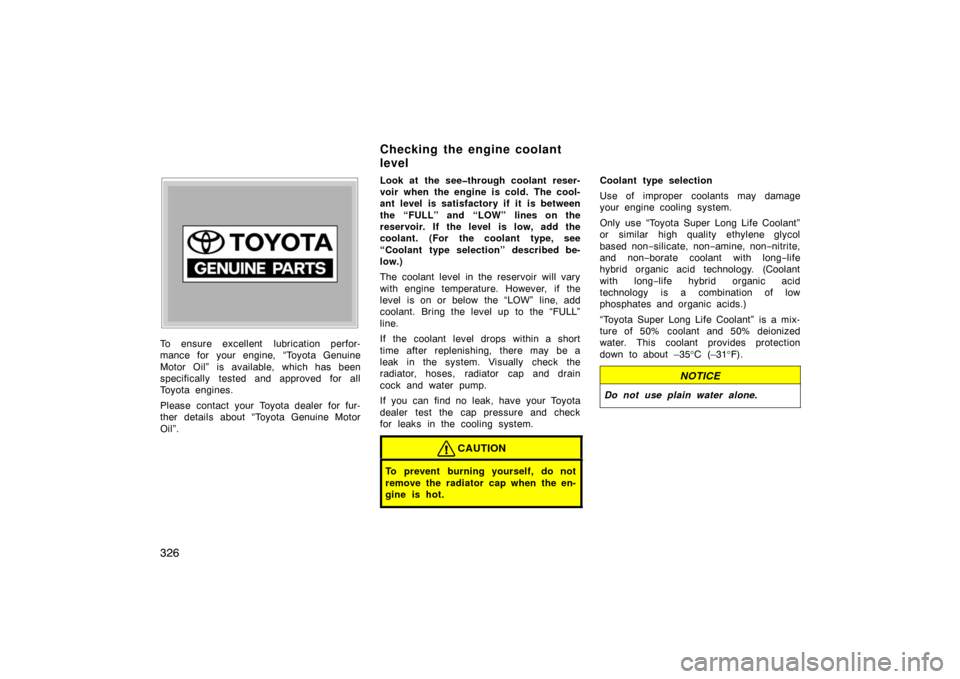
326
To ensure excellent lubrication perfor-
mance for your engine, “Toyota Genuine
Motor Oil” is available, which has been
specifically tested and approved for all
Toyota engines.
Please contact your Toyota dealer for fur-
ther details about “Toyota Genuine Motor
Oil”.Look at the see�through coolant reser-
voir when the engine is cold. The cool-
ant level is satisfactory if it is between
the “FULL” and “LOW” lines on the
reservoir. If the level is low, add the
coolant. (For the coolant type, see
“Coolant type selection” described be-
low.)
The coolant level in the reservoir will vary
with engine temperature. However, if the
level is on or below the “LOW” line, add
coolant. Bring the level up to the “FULL”
line.
If the coolant level drops within a short
time after replenishing, there may be a
leak in the system. Visually check the
radiator, hoses, radiator cap and drain
cock and water pump.
If you can find no leak, have your Toyota
dealer test the cap pressure and check
for leaks in the cooling system.
CAUTION
To prevent burning yourself, do not
remove the radiator cap when the en-
gine is hot.
Coolant type selection
Use of improper coolants may damage
your engine cooling system.
Only use “Toyota Super Long Life Coolant”
or similar high quality ethylene glycol
based non
−silicate, non −amine, non− nitrite,
and non− borate coolant with long −life
hybrid organic acid technology. (Coolant
with long −life hybrid organic acid
technology is a combination of low
phosphates and organic acids.)
“Toyota Super Long Life Coolant” is a mix-
ture of 50% coolant and 50% deionized
water. This coolant provides protection
down to about –35 °C (–31 °F).
NOTICE
Do not use plain water alone.
Checking the engine coolant
level
Page 341 of 374
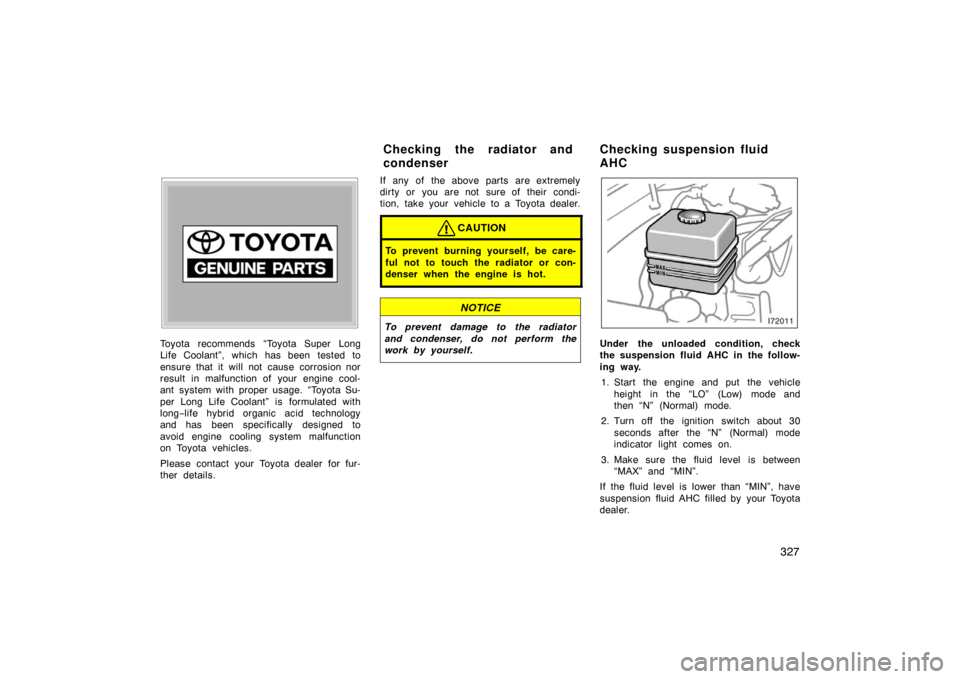
327
Toyota recommends “Toyota Super Long
Life Coolant”, which has been tested to
ensure that it will not cause corrosion nor
result in malfunction of your engine cool-
ant system with proper usage. “Toyota Su-
per Long Life Coolant” is formulated with
long−life hybrid organic acid technology
and has been specifically designed to
avoid engine cooling system malfunction
on Toyota vehicles.
Please contact your Toyota dealer for fur-
ther details. If any of the above parts are extremely
dirty or you are not sure of their condi-
tion, take your vehicle to a Toyota dealer.
CAUTION
To prevent burning yourself, be care-
ful not to touch the radiator or con-
denser when the engine is hot.
NOTICE
To prevent damage to the radiator
and condenser, do not perform the
work by yourself.
Under the unloaded condition, check
the suspension fluid AHC in the follow-
ing way.
1. Start the engine and put the vehicle height in the “LO” (Low) mode and
then “N” (Normal) mode.
2. Turn off the ignition switch about 30 seconds after the “N” (Normal) mode
indicator light comes on.
3. Make sure the fluid level is between “MAX” and “MIN”.
If the fluid level is lower than “MIN”, have
suspension fluid AHC filled by your Toyota
dealer.
Checking the radiator and
condenser Checking suspension fluid
AHC
Page 342 of 374
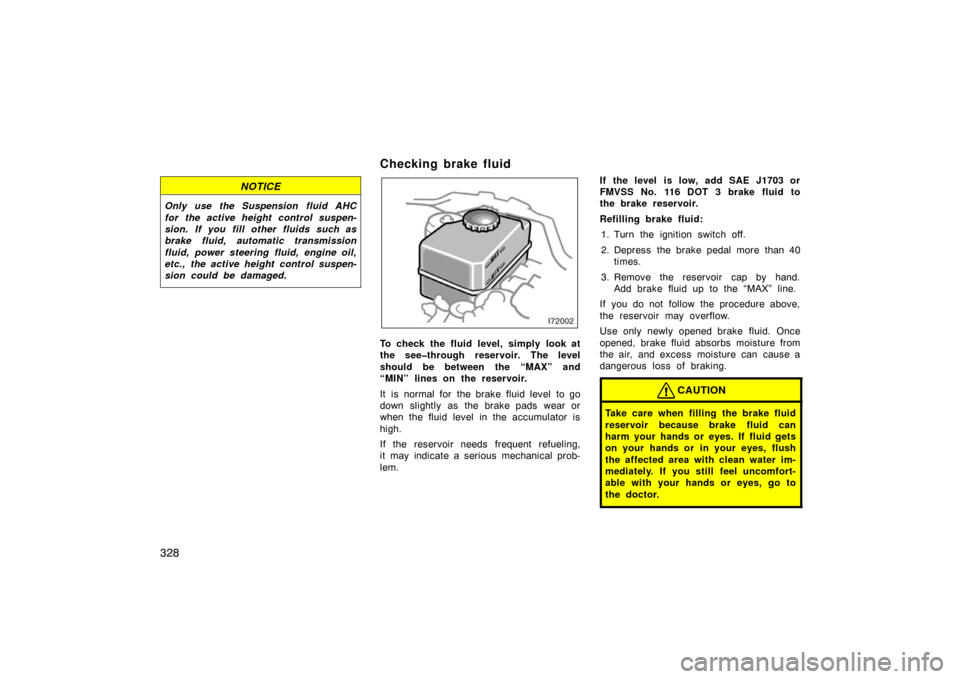
328
NOTICE
Only use the Suspension fluid AHC
for the active height control suspen-
sion. If you fill other fluids such as
brake fluid, automatic transmission
fluid, power steering fluid, engine oil,
etc., the active height control suspen-
sion could be damaged.
Checking brake fluid
To check the fluid level, simply look at
the see�through reservoir. The level
should be between the “MAX” and
“MIN” lines on the reservoir.
It is normal for the brake fluid level to go
down slightly as the brake pads wear or
when the fluid level in the accumulator is
high.
If the reservoir needs frequent refueling,
it may indicate a serious mechanical prob-
lem.If the level is low, add SAE J1703 or
FMVSS No. 116 DOT 3 brake fluid to
the brake reservoir.
Refilling brake fluid:
1. Turn the ignition switch off.
2. Depress the brake pedal more than 40 times.
3. Remove the reservoir cap by hand. Add brake fluid up to the “MAX” line.
If you do not follow the procedure above,
the reservoir may overflow.
Use only newly opened brake fluid. Once
opened, brake fluid absorbs moisture from
the air, and excess moisture can cause a
dangerous loss of braking.
CAUTION
Take care when filling the brake fluid
reservoir because brake fluid can
harm your hands or eyes. If fluid gets
on your hands or in your eyes, flush
the affected area with clean water im-
mediately. If you still feel uncomfort-
able with your hands or eyes, go to
the doctor.
Page 343 of 374
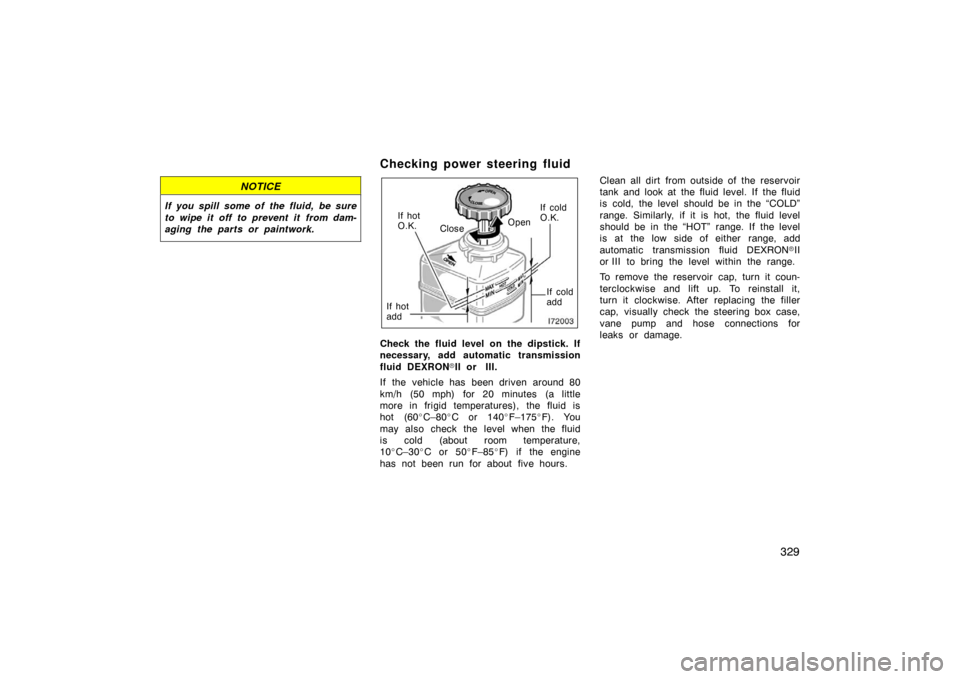
329
NOTICE
If you spill some of the fluid, be sure
to wipe it off to prevent it from dam-
aging the parts or paintwork.
Checking power steering fluid
Open
Close If cold
O.K.
If cold
add
If hot
O.K.
If hot
add
Check the fluid level on the dipstick. If
necessary, add automatic transmission
fluid DEXRON \bII or III.
If the vehicle has been driven around 80
km/h (50 mph) for 20 minutes (a little
more in frigid temperatures), the fluid is
hot (60 �C–80 �C or 140 �F–175 �F). You
may also check the level when the fluid
is cold (about room temperature,
10 �C–30 �C or 50 �F–85 �F) if the engine
has not been run for about five hours. Clean all dirt from outside of the reservoir
tank and look at the fluid level. If the fluid
is cold, the level should be in the “COLD”
range. Similarly, if it is hot, the fluid level
should be in the “HOT” range. If the level
is at the low side of either range, add
automatic transmission fluid DEXRON
\bII
or III to bring the level within the range.
To remove the reservoir cap, turn it coun-
terclockwise and lift up. To reinstall it,
turn it clockwise. After replacing the filler
cap, visually check the steering box case,
vane pump and hose connections for
leaks or damage.
Page 355 of 374
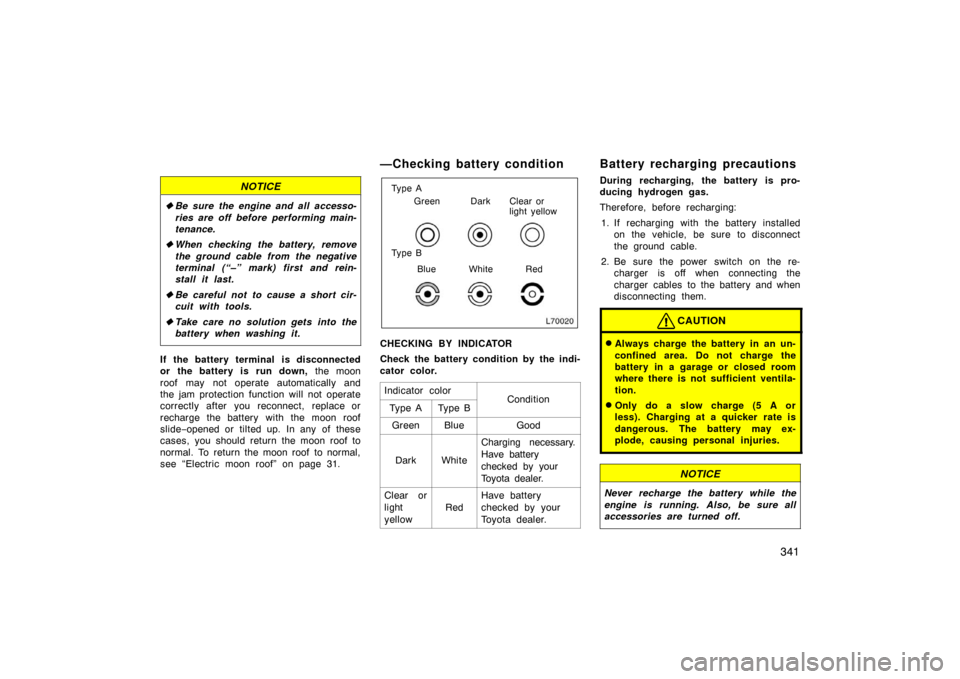
341
NOTICE
�Be sure the engine and all accesso-
ries are off before performing main-
tenance.
� When checking the battery, remove
the ground cable from the negative
terminal (“–” mark) first and rein-
stall it last.
� Be careful not to cause a short cir-
cuit with tools.
� Take care no solution gets into the
battery when washing it.
If the battery terminal is disconnected
or the battery is run down, the moon
roof may not operate automatically and
the jam protection function will not operate
correctly after you reconnect, replace or
recharge the battery with the moon roof
slide −opened or tilted up. In any of these
cases, you should return the moon roof to
normal. To return the moon roof to normal,
see “Electric moon roof” on page 31.
—Checking battery c ondition
Ty p e A
Ty p e BGreen Dark Clear or
light yellow
Blue White Red
CHECKING BY INDICATOR
Check the battery condition by the indi-
cator color. Indicator color
ConditionTy p e ATy p e B
GreenBlueGood
DarkWhite
Charging necessary.
Have battery
checked by your
Toyota dealer.
Clear or
light
yellow
Red
Have battery
checked by your
Toyota dealer.
Battery recharging precautions
During recharging, the battery is pro-
ducing hydrogen gas.
Therefore, before recharging:1. If recharging with the battery installed on the vehicle, be sure to disconnect
the ground cable.
2. Be sure the power switch on the re- charger is off when connecting the
charger cables to the battery and when
disconnecting them.
CAUTION
�Always charge the battery in an un-
confined area. Do not charge the
battery in a garage or closed room
where there is not sufficient ventila-
tion.
�Only do a slow charge (5 A or
less). Charging at a quicker rate is
dangerous. The battery may ex-
plode, causing personal injuries.
NOTICE
Never recharge the battery while the
engine is running. Also, be sure all
accessories are turned off.
Page 365 of 374
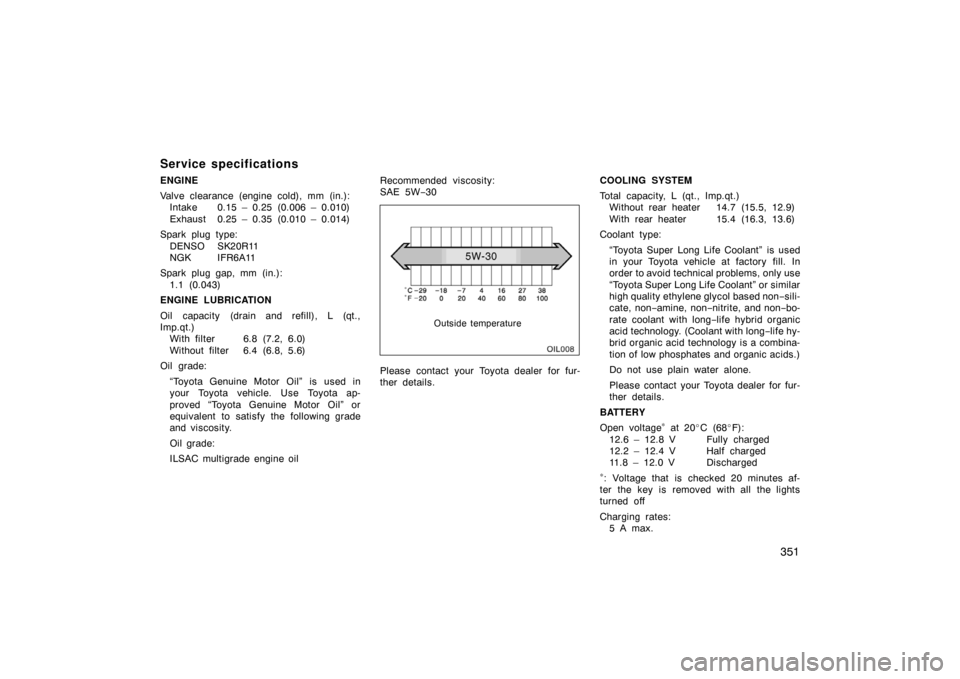
351
Service specifications
ENGINE
Valve clearance (engine cold), mm (in.):Intake 0.15 – 0.25 (0.006 – 0.010)
Exhaust 0.25 – 0.35 (0.010 – 0.014)
Spark plug type: DENSO SK20R11
NGK IFR6A11
Spark plug gap, mm (in.): 1.1 (0.043)
ENGINE LUBRICATION
Oil capacity (drain and refill), L (qt.,
Imp.qt.) With filter 6.8 (7.2, 6.0)
Without filter 6.4 (6.8, 5.6)
Oil grade:
“Toyota Genuine Motor Oil” is used in
your Toyota vehicle. Use Toyota ap-
proved “Toyota Genuine Motor Oil” or
equivalent to satisfy the following grade
and viscosity.
Oil grade:
ILSAC multigrade engine oil Recommended viscosity:
SAE 5W
−30
Outside temperature
Please contact your Toyota dealer for fur-
ther details. COOLING SYSTEM
Total capacity, L (qt., Imp.qt.)
Without rear heater 14.7 (15.5, 12.9)
With rear heater 15.4 (16.3, 13.6)
Coolant type:
“Toyota Super Long Life Coolant” is used
in your Toyota vehicle at factory fill. In
order to avoid technical problems, only use
“Toyota Super Long Life Coolant” or similar
high quality ethylene glycol based non −sili-
cate, non −amine, non− nitrite, and non− bo-
rate coolant with long −life hybrid organic
acid technology. (Coolant with long −life hy-
brid organic acid technology is a combina-
tion of low phosphates and organic acids.)
Do not use plain water alone.
Please contact your Toyota dealer for fur-
ther details.
BATTERY
Open voltage
∗ at 20 �C (68 �F):
12.6 – 12.8 V Fully charged
12.2 – 12.4 V Half charged
11.8 – 12.0 V Discharged
∗: Voltage that is checked 20 minutes af-
ter the key is removed with all the lights
turned off
Charging rates: 5 A max.